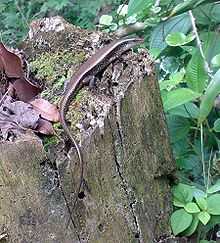Eutropis multifasciata
| East Indian Brown Mabuya | |
|---|---|
 | |
| Scientific classification | |
| Kingdom: | Animalia |
| Phylum: | Chordata |
| Class: | Reptilia |
| Order: | Squamata |
| Suborder: | Sauria |
| Family: | Scincidae |
| Genus: | Eutropis |
| Species: | E. multifasciata |
| Binomial name | |
| Eutropis multifasciata (Kuhl, 1820) | |
| Synonyms [1] | |
| |
The East Indian Brown Mabuya (Eutropis multifasciata), also known as Many-lined Sun Skink, Many-striped Skink, Common Sun Skink or (ambiguously) as "golden skink", is a species of skink.
Description
- See Snake scales for terminology
Snout moderate,obtuse. Lower eyelid scaly. Nostril behind vertical of the suture between rostral and first labial; a postnasal; anterior loreal not deeper than the second, in contact with the first labial; supranasals frequently in contact behind rostral; frontonasal broader than long; prefrontals constantly forming a median suture; frontal as long as or shorter than the frontoparietals and interparietal together, in contact with the second (rarely also with the first) supraocular: 4 supraoculars, second largest; 6 supraciliaries, first largest; fronto-parietals distinct, larger than the interparietal, which entirely separates the parietals; a pair of nuchals, 4 labials anterior to the subocular, which is large and not narrower below. Ear-opening roundish or oval, as large as a lateral scale, or a little smaller, with or without a few very small lobules anteriorly. Dorsal scales more or less distinctly tri-(rarely quinque-) carinate: nuchals and laterals usually very feebly keeled, sometimes smooth; 30 to 34 scales round the middle of the body, subequal or dorsals largest. The hind limb reaches the wrist or the elbow of the adpressed fore limb. Subdigital lamellae smooth. Scales on upper surface of tibia mostly tricarinate. Tail 1.3 to 1.6 times length of head and body. Brown or olive above ; some specimens uniform, or with a large whitish (red) patch on each side; back frequently with small black spots, sometimes confluent into longitudinal lines; sides frequently dark brown, with whitish, black-edged ocelli; a well-defined light dorso-lateral band seldom present; lower surfaces yellowish or greenish white.[2]
Distribution
From India (Assam) to S China, China (Taiwan, Hainan, Yunnan) Thailand (incl. Phuket), Myanmar (= Burma), Laos, Cambodia, Vietnam, Malaysian Peninsula, Pulau Tioman, Johor: Pulau Besar, Pulau Sibu, Singapore, Indonesia (Borneo, Sumatra, Java, Bali), New Guinea, The Philippines (Negros, Panay, Palawan: Calamian Islands, Luzon)
Notes
- ↑ http://reptile-database.reptarium.cz/species.php?genus=Eutropis&species=multifasciata
- ↑ Boulenger, G. A. 1890. Fauna of British India. Reptilia and Batrachia.
References
- Annandale,Nelson 1905 Contributions to Oriental Herpetology. Suppl. III. Notes on the Oriental lizards in the Indian Museum, with a list of the species recorded from British India and Ceylon. J. Asiat. Soc. Bengal (2) 1: 139-151
- Gray, J. E. 1853 Descriptions of some undescribed species of reptiles collected by Dr. Joseph Hooker in the Khassia Mountains, East Bengal, and Sikkim Himalaya. Ann. Mag. Nat. Hist. (2) 12: 386 - 392
- Kuhl, H. 1820 Beiträge zur Kenntnis der Amphibien. In: KUHL, H.: Beiträge zur Zoologie und Vergleichenden Anatomie. Frankfurt a.M. (Hermannsche Buchhandlung): 75-132.
- Mausfeld,P.; Vences, M. Schmitz, A. & Veith, M. 2000 First data on the molecular phylogeography of scincid lizards of the genus Mabuya. Mol. Phylogenet. Evol. 17 (1): 11-14
- Mausfeld, Patrick & Andreas Schmitz 2003 Molecular phylogeography, intraspecific variation and speciation of the Asian scincid lizard genus Eutropis Fitzinger, 1843 (Squamata: Reptilia: Scincidae): taxonomic and biogeographic implications. Org. Divers. Evol. 3: 161-171
External links
- Mabuya multifasciata at the Reptarium.cz Reptile Database
- http://itgmv1.fzk.de/www/itg/uetz/herp/photos/Mabuya_multifasciata.jpg
- http://itgmv1.fzk.de/www/itg/uetz/herp/photos/Mabuya_multifasciata2.jpg